Abstract
We studied the penetration of three azole compounds, ketoconazole, itraconazole, and fluconazole, into the ocular tissues and fluids of rabbits in the presence and absence of ocular inflammation. Drug concentrations were compared with those found in serum and cerebrospinal fluid. The rank order of penetration into eye tissue was fluconazole greater than ketoconazole greater than itraconazole. Fluconazole penetrated freely into both inflamed and uninflamed eyes. The presence of inflammation improved penetration of all three compounds into ocular fluids and tissues. Penetration of these azoles into the anterior chamber of uninflamed eyes and into the cerebrospinal fluid was similar. All three azole compounds reduced the number of yeasts found in the eye in hematogenous Candida albicans endophthalmitis in rabbits when therapy was initiated within 24 h of inoculation. However, only ketoconazole significantly reduced yeast counts in the eye when therapy was postponed for 7 days.
Full text
PDF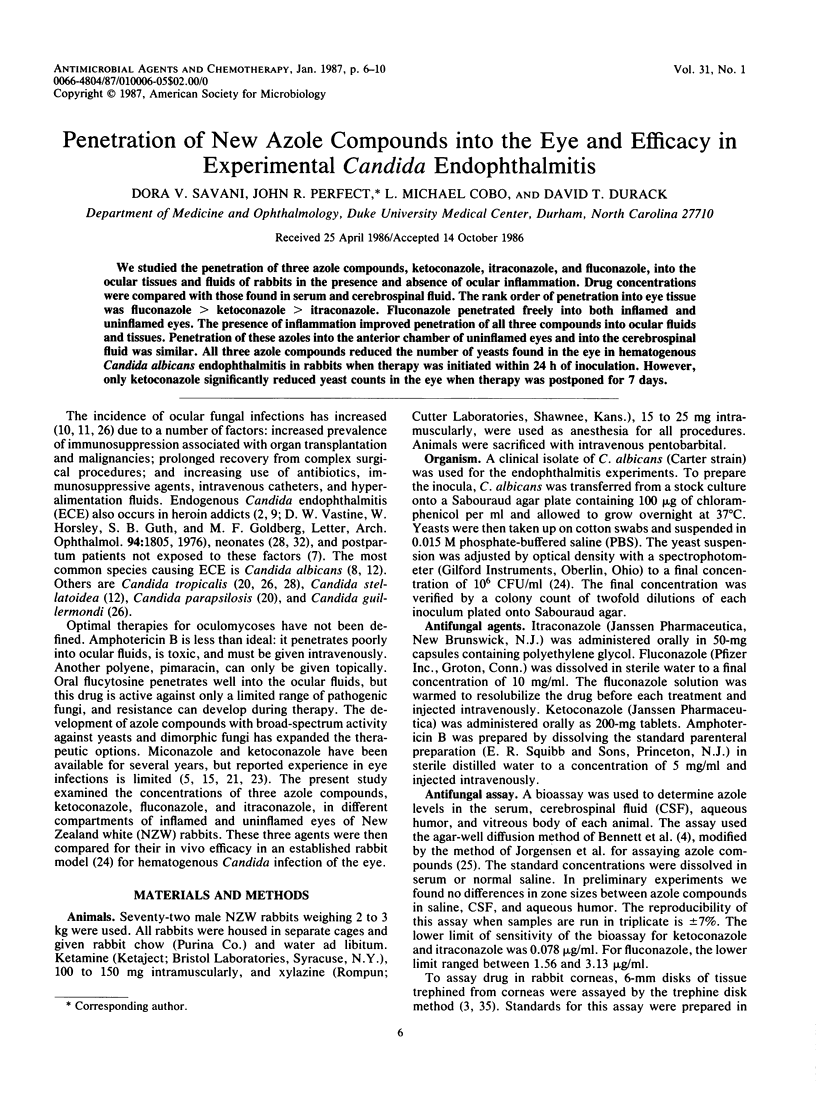
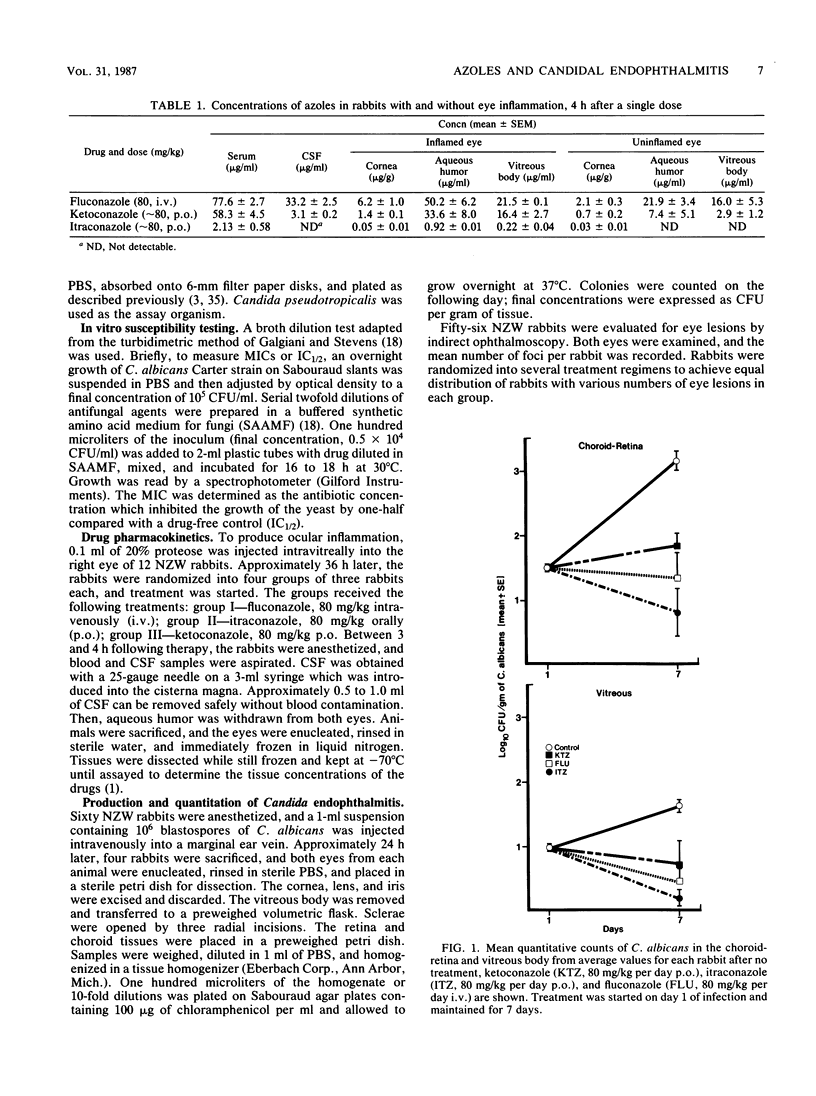
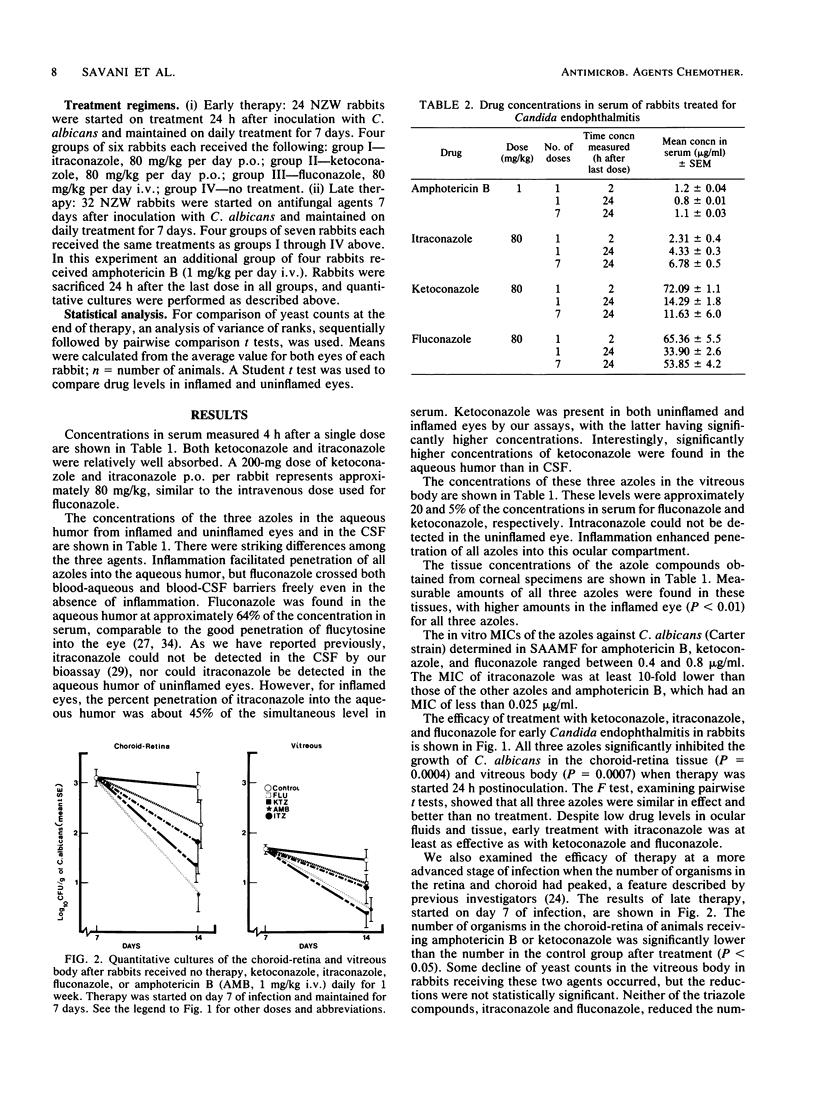
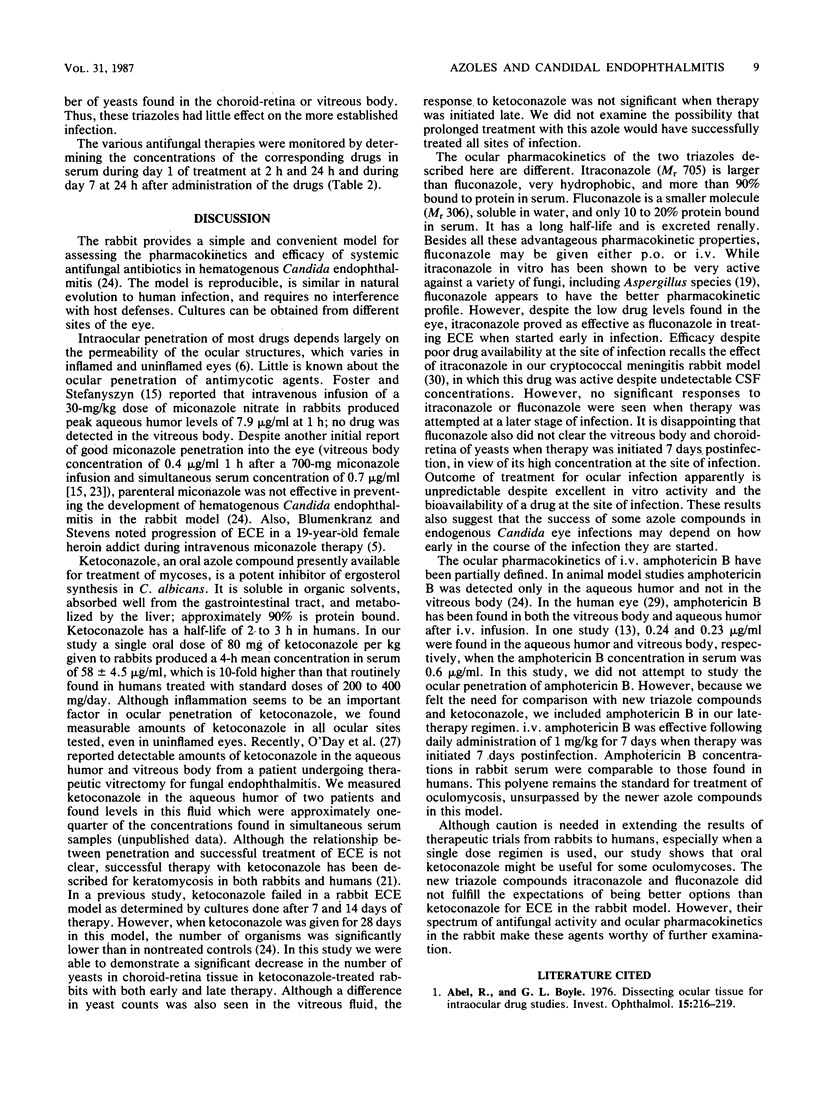
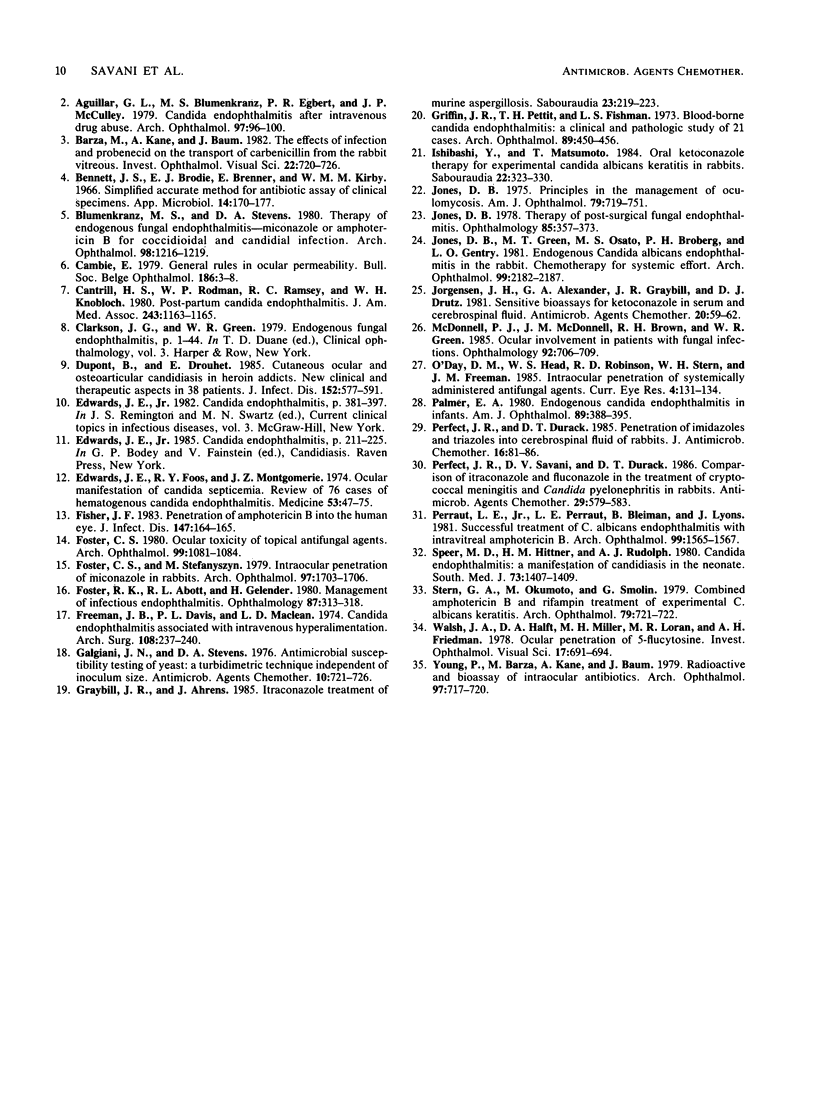
Selected References
These references are in PubMed. This may not be the complete list of references from this article.
- Abel R., Jr, Boyle G. L. Dissecting ocular tissue for intraocular drug studies. Invest Ophthalmol. 1976 Mar;15(3):216–219. [PubMed] [Google Scholar]
- Aguilar G. L., Blumenkrantz M. S., Egbert P. R., McCulley J. P. Candida endophthalmitis after intravenous drug abuse. Arch Ophthalmol. 1979 Jan;97(1):96–100. doi: 10.1001/archopht.1979.01020010036008. [DOI] [PubMed] [Google Scholar]
- Barza M., Kane A., Baum J. The effects of infection and probenecid on the transport of carbenicillin from the rabbit vitreous humor. Invest Ophthalmol Vis Sci. 1982 Jun;22(6):720–726. [PubMed] [Google Scholar]
- Bennett J. V., Brodie J. L., Benner E. J., Kirby W. M. Simplified, accurate method for antibiotic assay of clinical specimens. Appl Microbiol. 1966 Mar;14(2):170–177. doi: 10.1128/am.14.2.170-177.1966. [DOI] [PMC free article] [PubMed] [Google Scholar]
- Blumenkranz M. S., Stevens D. A. Therapy of endogenous fungal endophthalmitis: miconazole or amphotericin B for coccidioidal and candidal infection. Arch Ophthalmol. 1980 Jul;98(7):1216–1220. doi: 10.1001/archopht.1980.01020040068006. [DOI] [PubMed] [Google Scholar]
- Cambie E. General rules in ocular permeability. Bull Soc Belge Ophtalmol. 1979;186:3–8. [PubMed] [Google Scholar]
- Cantrill H. L., Rodman W. P., Ramsay R. C., Knobloch W. H. Postpartum Candida endophthalmitis. JAMA. 1980 Mar 21;243(11):1163–1165. [PubMed] [Google Scholar]
- Dupont B., Drouhet E. Cutaneous, ocular, and osteoarticular candidiasis in heroin addicts: new clinical and therapeutic aspects in 38 patients. J Infect Dis. 1985 Sep;152(3):577–591. doi: 10.1093/infdis/152.3.577. [DOI] [PubMed] [Google Scholar]
- Edwards J. E., Jr, Foos R. Y., Montgomerie J. Z., Guze L. B. Ocular manifestations of Candida septicemia: review of seventy-six cases of hematogenous Candida endophthalmitis. Medicine (Baltimore) 1974 Jan;53(1):47–75. doi: 10.1097/00005792-197401000-00002. [DOI] [PubMed] [Google Scholar]
- Fisher J. F., Taylor A. T., Clark J., Rao R., Espinel-Ingroff A. Penetration of amphotericin B into the human eye. J Infect Dis. 1983 Jan;147(1):164–164. doi: 10.1093/infdis/147.1.164. [DOI] [PubMed] [Google Scholar]
- Forster R. K., Abbott R. L., Gelender H. Management of infectious endophthalmitis. Ophthalmology. 1980 Apr;87(4):313–319. doi: 10.1016/s0161-6420(80)35241-x. [DOI] [PubMed] [Google Scholar]
- Foster C. S., Lass J. H., Moran-Wallace K., Giovanoni R. Ocular toxicity of topical antifungal agents. Arch Ophthalmol. 1981 Jun;99(6):1081–1084. doi: 10.1001/archopht.1981.03930011081019. [DOI] [PubMed] [Google Scholar]
- Foster C. S., Stefanyszyn M. Intraocular penetration of miconazole in rabbits. Arch Ophthalmol. 1979 Sep;97(9):1703–1706. doi: 10.1001/archopht.1979.01020020271017. [DOI] [PubMed] [Google Scholar]
- Freeman J. B., Davis P. L., MacLean L. D. Candida endophthalmitis associated with intravenous hyperalimentation. Arch Surg. 1974 Feb;108(2):237–240. doi: 10.1001/archsurg.1974.01350260089022. [DOI] [PubMed] [Google Scholar]
- Galgiani J. N., Stevens D. A. Antimicrobial susceptibility testing of yeasts: a turbidimetric technique independent of inoculum size. Antimicrob Agents Chemother. 1976 Oct;10(4):721–728. doi: 10.1128/aac.10.4.721. [DOI] [PMC free article] [PubMed] [Google Scholar]
- Graybill J. R., Ahrens J. Itraconazole treatment of murine aspergillosis. Sabouraudia. 1985 Jun;23(3):219–223. doi: 10.1080/00362178585380321. [DOI] [PubMed] [Google Scholar]
- Griffin J. R., Pettit T. H., Fishman L. S., Foos R. Y. Blood-borne Candida endophthalmitis. A clinical and pathologic study of 21 cases. Arch Ophthalmol. 1973 Jun;89(6):450–456. doi: 10.1001/archopht.1973.01000040452002. [DOI] [PubMed] [Google Scholar]
- Ishibashi Y., Matsumoto Y. Oral ketoconazole therapy for experimental candida albicans keratitis in rabbits. Sabouraudia. 1984;22(4):323–330. [PubMed] [Google Scholar]
- Jones B. R. Principles in the management of oculomycosis. XXXI Edward Jackson memorial lecture. Am J Ophthalmol. 1975 May;79(5):719–751. doi: 10.1016/0002-9394(75)90730-8. [DOI] [PubMed] [Google Scholar]
- Jones D. B., Green M. T., Osato M. S., Broberg P. H., Gentry L. O. Endogenous Candida albicans endophthalmitis in the rabbit. Chemotherapy for systemic effect. Arch Ophthalmol. 1981 Dec;99(12):2182–2187. doi: 10.1001/archopht.1981.03930021058014. [DOI] [PubMed] [Google Scholar]
- Jones D. B. Therapy of postsurgical fungal endophthalmitis. Ophthalmology. 1978 Apr;85(4):357–373. doi: 10.1016/s0161-6420(78)35664-5. [DOI] [PubMed] [Google Scholar]
- Jorgensen J. H., Alexander G. A., Graybill J. R., Drutz D. J. Sensitive bioassay for ketoconazole in serum and cerebrospinal fluid. Antimicrob Agents Chemother. 1981 Jul;20(1):59–62. doi: 10.1128/aac.20.1.59. [DOI] [PMC free article] [PubMed] [Google Scholar]
- McDonnell P. J., McDonnell J. M., Brown R. H., Green W. R. Ocular involvement in patients with fungal infections. Ophthalmology. 1985 May;92(5):706–709. doi: 10.1016/s0161-6420(85)33989-1. [DOI] [PubMed] [Google Scholar]
- O'Day D. M., Head W. S., Robinson R. D., Stern W. H., Freeman J. M. Intraocular penetration of systemically administered antifungal agents. Curr Eye Res. 1985 Feb;4(2):131–134. doi: 10.3109/02713688508999978. [DOI] [PubMed] [Google Scholar]
- Palmer E. A. Endogenous Candida endophthalmitis in infants. Am J Ophthalmol. 1980 Mar;89(3):388–395. doi: 10.1016/0002-9394(80)90009-4. [DOI] [PubMed] [Google Scholar]
- Perfect J. R., Durack D. T. Penetration of imidazoles and triazoles into cerebrospinal fluid of rabbits. J Antimicrob Chemother. 1985 Jul;16(1):81–86. doi: 10.1093/jac/16.1.81. [DOI] [PubMed] [Google Scholar]
- Perfect J. R., Savani D. V., Durack D. T. Comparison of itraconazole and fluconazole in treatment of cryptococcal meningitis and candida pyelonephritis in rabbits. Antimicrob Agents Chemother. 1986 Apr;29(4):579–583. doi: 10.1128/aac.29.4.579. [DOI] [PMC free article] [PubMed] [Google Scholar]
- Perraut L. E., Jr, Perraut L. E., Bleiman B., Lyons J. Successful treatment of Candida albicans endophthalmitis with intravitreal amphotericin B. Arch Ophthalmol. 1981 Sep;99(9):1565–1567. doi: 10.1001/archopht.1981.03930020439006. [DOI] [PubMed] [Google Scholar]
- Speer M. E., Hittner H. M., Rudolph A. J. Candida endophthalmitis: a manifestation of candidiasis in the neonate. South Med J. 1980 Oct;73(10):1407–1409. [PubMed] [Google Scholar]
- Stern G. A., Okumoto M., Smolin G. Combined amphotericin B and rifampin treatment of experimental Candida albicans keratitis. Arch Ophthalmol. 1979 Apr;97(4):721–722. doi: 10.1001/archopht.1979.01020010373020. [DOI] [PubMed] [Google Scholar]
- Walsh A., Haft D. A., Miller M. H., Loran M. R., Friedman A. H. Ocular penetration of 5-fluorocytosine. Invest Ophthalmol Vis Sci. 1978 Jul;17(7):691–694. [PubMed] [Google Scholar]
- Young P., Barza M., Kane A., Baum J. Radioactive and bioassay of intraocular antibiotics: double-assay technique to compare penicillin G, cefamandole, and gentamicin in ocular tissues in vivo. Arch Ophthalmol. 1979 Apr;97(4):717–720. doi: 10.1001/archopht.1979.01020010369019. [DOI] [PubMed] [Google Scholar]


